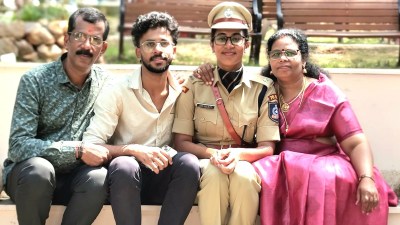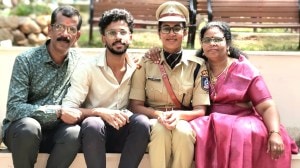Best of Both Worlds
Your heart swings back from the far past,traces its lost steps. In a sudden rush,All around, your former knowledge of life returns...Besides...

Your heart swings back from the far past,
traces its lost steps. In a sudden rush,
All around, your former knowledge of life returns…
Besides a sea of mystery none can cross
You know afresh what you have always known.
— Ahalya, Rabindranath Tagore.
Who reads in English today? Those, whose great-grandparents learnt English from the English. And the Much Younger People, first-gen English medium types who use the American model, like call centre kids. The fact is that Mamma (not Mum or Mom) read cosy English magazines like Woman’s Weekly and Woman & Home, which had nice knitting patterns, a short love story, a serialised long love story, recipes for bangers and mash (sausages and hash browns), Yorkshire pudding and gooseberry marmalade. The very dashing Mammas used Coty and Helena Rubinstein lipstick, drenched themselves in Chanel No 5 or Miss Dior and wore butterfly-frame dark glasses and high heels with equal elan to the Shanmukhananda Sabha, the Willingdon or Gymkhana and the Mahalaxmi Race Course. They were addicted to Tatler and Vogue, despite the latter being American and the former about a titled society, technically nauseating to democratic India.
But the Atlantic was truly crossed in early ’80s as Indian magazines and papers began to smarten up with offest printing. Colour and cable TV came in with Asiad 82. Mamma’s daughters yawned over Woman’s Weekly. They rented Cosmopolitan instead from the magazinewala. Cosmo was a downmarket read back home in America, but it was those late Seventies and Eighties girls who first wore jeans on the U-Specials and passed around Helen Gurley Brown’s Sex and the Single Girl, suitably sheathed in newspaper. Mamma had had to recite “Lord Ullin’s Daughter” or “Fidelity” by William Wordsworth to win approval and ice cream money. She read Montaigne’s essays, Cyrano de Bergerac, Kai Lung by Ernest Brahma, Homer and Euripides in Penguin translation and all the European classics like War and Peace, The Idiot, Madame Bovary, the Shakespearean sonnets. Mamma’s daughter preferred J.D. Salinger, Saul Bellow, Louis L’Amour and Mario Puzo. The only peace at home was brokered by P.G. Wodehouse.
So crowded was the Atlantic crossing, that another sea stayed unexplored by many. Ancestral voices called it the Bhavsagar, the Ocean of Existence. But this metaphor for life also meant the life of the mind, which directly applied to the books on the bedside table. Besides Rajaji’s Mahabharata and Ramayana and bound volumes of Amar Chitra Katha, there were very few Indians opened to the reading lamp. Macaulay had done his job well, for all that Max Mueller said, “If I am asked which nation had been advanced in respect to education and culture in the ancient world, I would say it is India.”
Nehru noted this in his letters to Indira, regretting his inability to read Shudraka’s Mrichchakatikam (The Little Clay Cart) in the original Sanskrit. Mamma and her daughters first heard the story in 1985 with Shashi Kapoor’s Hindi film, Utsav. They did not know — COULD not know — that this was the most realistic and modern of Indian plays. The Parisians had seen it in translation in 1850 and 1895, while in Germany it was a sell-out in 1892-3 and again in the 1920s. Kalidasa’s play Abhijnana Shaakuntalam (The Recognition of Shakuntala) was the first Indian play to be translated into English and then into German in 1791. It so enchanted Goethe that he borrowed from its structure and treatment for his own play, Faust, even citing Shakuntala in his Prologue in this heavy-footed but famously sincere verse:
Will ich die Blumen des Fruehen, die Fruechte des spaeteren Jahres,/ Will ich was reizt und entzuecht, will ich was saettigt und naehrt,/ Will ich den Himmel, die Erde mit einem Namen begreifen;/ Nenn ich Sakontala dich und so ist alles gesagt. (If I want the flowers of spring, the fruits of the later year,/ If I want what charms and delights, what satisfies and nourishes,/ If I want to grasp heaven and earth with a single name;/ I name you, Shakuntala, and all is said.)
Meanwhile Nehru, the epitome of Indian Eastwestism and a “verray perfect, gentle knight” to Mamma and her daughters, liberally garnished his autobiography with English poets like Matthew Arnold, Swinburne and even Walter de la Mare. But except for stray lines of significance like “Asatoma sadgamaya” from the Brihadaranyaka Upanishad, he could not spontaneously summon up one verse of note from Indian sources except secondhand through Bapu. It was enough though that “Panditji” felt the wound, for the anodyne appeared as three national academies: Sahitya, Sangeet Natak and Lalit Kala. Today they’re eyeball-deep in internal politics and bizarre parodies of feudal “mai-baap” culture. But Mamma didn’t care. She learnt a bit of Hindustani or Carnatic, she thumped away a few years at Kathak or Bharata Natyam, but the tiny corner of her house that was forever England was her bookshelf. Not for Mamma the Eighth Brahmana verse of the Brihadaranyaka Upanishad:
Speech Symbolised As A Cow: Vacam dhenu upasita. Tasyas chatvarah sthanah./ Svaha-karo vasat-karo hanta-kara svadha-karah./ Tsayai dvau sthanau deva upajivanti;/ Svaha-karam cha, vasat-karam cha./ Hantah-karam manusyah, svadha-karam cha pitarah./ Tasya prana rishabha mano vatsah. (One should meditate on speech as a milch cow. She has four udders, which are the sounds, svaha, vasat, hanta and svadha. The gods live on svaha and vasat, men on hanta and the “fathers” or ancestral spirits on svadha. The vital breath, prana, is her bull, the mind, manah, her calf.)
Here was an urgent ancestral voice, typically couched in a mysterious riddle, which exhorted the unborn generations to keep their culture alive though language. Breath seeded speech, like a bull fertilised a cow. Her udders were enriched by a double dose of divine grace and the collective memory of present and ancestral generations: The “calf” or mind that drank its fill of these “udders” would prosper. Our ancients, who counted cattle as wealth, paid language as the carrier of culture the highest compliment in their world by comparing it to a fertile milch cow.
But somewhere down the line, we may have finally got it, despite the muddles, like the neglect of Indian classical literature by the Left except as a source of proof for subaltern theories. For now, in the early 21st century, it seems good for our collective liver that these things happened. It’s not just our minds that crossed to America, they crossed, too. English scholars have been left behind by Americans like Diana Eck, Wendy Doniger and Martha Ann Selby, all blessedly free of colonial baggage, though Doniger may not always grasp nuance. She’s quite huffy, for instance, about Narada Muni, perhaps unaware in her American library that modern Hindus in the living stream of faith are rather fond of him. Or else, you have a European of brilliance like Roberto Calasso who remixes “Hinduism’s greatest hits” in books like Ka. Regional fiction has been systematically translated over the last decade. Translation is still a controversial issue, since everyone wants to be true to the mother tongue. And so you have things going bump on the page. “Poitu varen” in Tamil literally means “I’ll go and come back”. And that’s how Kaa Naa Subramanyam translates it. But for a modern reader it’s truer to English usage to say “I’ll be back” or “See you”. However the process is on, the dialogue continues, with Indian writers in English giving us yet another dimension: the direct transmission from thought to type, as though aware that the English term “vernacular” for our regional languages literally means “slave tongue” (from Latin). So it is historical justice, in 2004, to realise that the very language that Macaulay used to cut us off from our roots, is now working overtime to give back to us the lost treasures of our past.
Sometimes, we manage to help ourselves. Cut back to the 1970s and a cold, blustery day in Chicago. A young Tamilian teacher of English stands between the shelves of the university library. Suddenly, two rare old manuscripts of ancient Tamil literature fall into his hands. As the enormity of his discovery hits him, A.K. Ramanujan finds himself trembling. Nothing will ever be the same again. It really is possible, in our minds where we really live, to have the best of both worlds. Mom and her gals are gonna stay tuned.
Photos



- 01
- 02
- 03
- 04
- 05



























